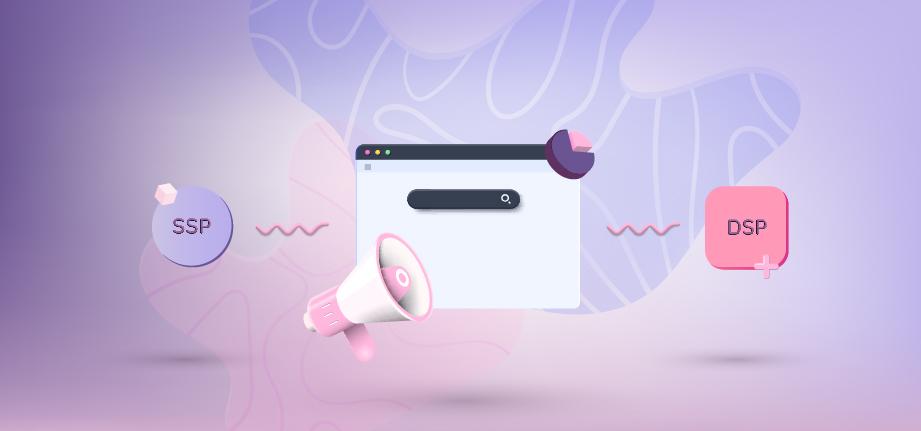Last Updated on: 10th May 2024, 09:09 am
The world of online advertising faces significant changes. Advanced technologies are not only addition that improves efficiency of marketing campaigns – they rule the market. Demand-side platforms (DSP) and supply-side platforms are two important elements of this automated market. Keep reading to learn more about them.
In this article you will learn:
- How has automation increased the efficiency of selling and buying ads?
- Who uses a supply-side platform?
- Who uses a demand-side platform?
- What are the differences and similarities between DSPs and SSPs?
Table of Contents:
- Improved efficiency of advertising thanks to automation
- The process of automated ad space selling explained
- What is an SSP (supply-side platform)?
- What is a DSP (demand-side platform)?
- The essential similarities and differences between SSP and DSP
- Summary
Improved efficiency of advertising thanks to automation
Before we provide you with a detailed comparison of DSPs and SSPs we have to describe the current state of the advertising market. In order to reach the highest advertising efficiency, companies tend to use advanced techniques to present the right ads, at the right moment and to the right user. This would not be possible without programmatic advertising, AI-based targeting solutions, deep learning, personalization, and automation. As the demand for advertising space increases, so does the competition between different brands. This is why the need for better automation on the advertiser’s side is continuously growing.
DSPs (demand-side platforms) allow advertising agencies to offer more automated, efficient processes. This brings targeting to a new level, but apart from an advanced system for managing and offering advertising space, advertisers also need a tool for selling inventory through various channels – that is why SSPs are also required.
The process of automated ad space sales explained
The purchasing process on the ads market starts when a user lands on a website with an ad slot. Ad networks place a piece of code on the publisher’s website for this slot which allows advertisers to place certain content in this destination using a DSP to manage ad network supplies. After the swift exchange of information between platforms, bid requests for the ad space offered on the SSP (supply-side platform) are sent to the demand-side platform, and they make bids automatically on behalf of the advertiser. The ad exchange gathers all the bids and chooses the winner – sounds simple, right? As the process is automated as much as possible, it lasts less than a fraction of a second. But what exactly are DSPs and SSPs?
What is an SSP (supply-side platform)?
Those who have an online advertising inventory of their own can use an integrated supply-side platform (SSP) to sell it via an auction mechanism, leveraging automation directly from the ad server in real time (via RTB). Simply put, such a platform provides solutions and resources that give publishers tools to aggregate, consolidate, and manage their demand sources. SSP advertising enables publishers to make their ad inventory available to large demand, thus providing the opportunity to increase their ad revenue. In short, supply-side platforms serve to automate the process of publishers running RTB auctions and evaluating bids. Still, it is important to remember that SSPs may not offer the highest price on the market for your ad inventory – each SSP competes with others and has its own network of buyers.
SSPs challenges in the cookieless world
As third party cookies are very often used to save users’ data for personalization purposes, the discussions about removing them from Google Chrome and the potential results are quite intense. How will you display ads in the cookieless world? Client information allows advertising technology vendors to offer high level targeting and personalization. The removal of third-party cookies means that both advertisers and publishers have to adjust to the new reality and standards by implementing new solutions.
In this situation, a big group of publishers can benefit from the capability to monetize their direct audience first party data. However, before they do so, they will have to prove the value of their offer to potential buyers on the market. It is also crucial for them to make sure that their post-3rd party cookies comply with the current Privacy Sandbox requirements, so they can make use of demand-side platforms and this method to bid. RTB House is among the DSP leaders when it comes to getting ready for the cookieless future of online advertising.
What is a DSP (demand-side platform)?
A DSP is a type of software that allows an advertiser to buy advertising space from publishers with the help of automation so they can satisfy their specific demand. Such a platform allows advertisers to bid on auctions from multiple publishers. Basically, advertisers need DSPs (demand-side platforms) in order to set ads and leverage audience targeting, as well as managing and optimizing bids.
The essential similarities and differences between SSPs and DSPs
Basically, DSPs and SSPs are the same thing for different users, they bring advertisers and publishers together and allow them to work together. These platforms in fact complement each other. What are their similarities and differences?
DSPs and SSPs similarities
- The users of these platforms ultimately have the same goal – increasing the efficiency of their advertising activities. DSPs are for marketers and advertisers looking to find a platform that will give them the most impact and control over their ads. SSPs are for publishers, whose main purpose is to sell ads at the best price level to the demand side.
- Those who are interested in a comparison of demand-side platforms vs. supply-side platforms should be aware that both those types of platforms are powered by similar technologies (such as deep learning).
DSP vs. SSP – differences
- They have different end users. DSPs are used by marketers and advertisers to increase the efficiency of their clients’ campaigns and SSPs end users are publishers who want to sell their advertising space.
- As these two platforms serve different groups of users, they enable them to do different things. An SSP lets publishers sell their ad inventory across different ad exchanges, while a DSP enables advertisers to buy the required advertising space across several different ad exchanges at the same time.
- DSPs allow advertisers to leverage audience targeting, SSPs run a real time auction and serve the ads. DSPs have a narrow focus.
- DSPs enable advertisers to optimize various campaigns. SSPs are a kind of software that brings together inventory, multiple ad networks, ad exchanges and DSPs – all at the same time.
Summary
DSPs and SSPs bring together advertisers and publishers and enable the first group to buy advertising space from the second group. DSP users benefit from access to scalable, direct solutions to reach a certain target audience at the proper time, place and under the right context. SSP users are gaining software that allows them to control their digital ad inventory and sell their advertising space for a good price. Leveraging automation on the advertising market significantly increases the efficiency of online advertising and ensures high revenue to the publishers. The time to take advantage from modern technologies is now. Don’t let your competition do it first – allow us to boost your campaigns. Contact us to learn more.





